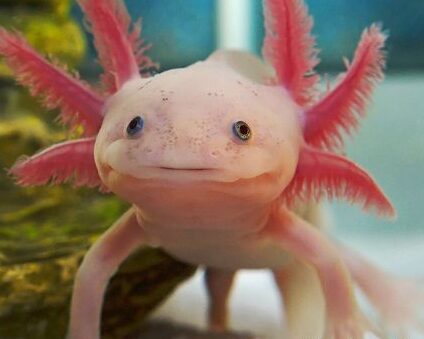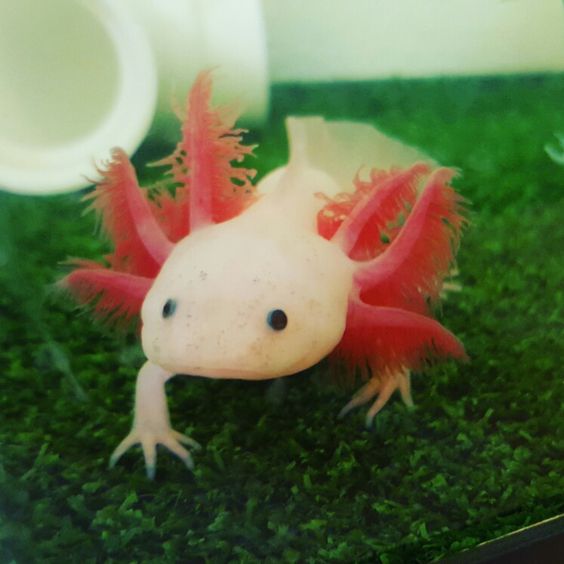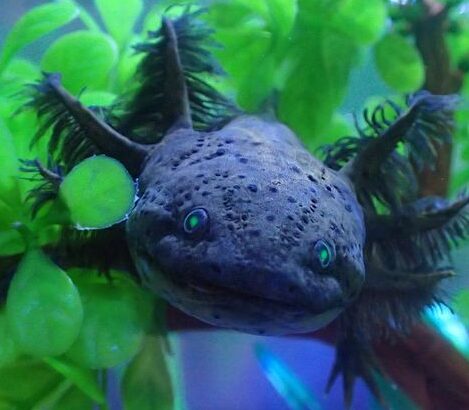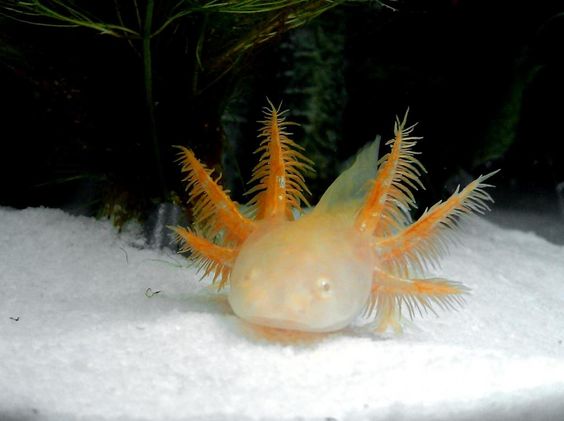
The leucistic axolotl, a captivating aquatic creature, stands out as a unique variant of the axolotl species. With its enchanting pale or white coloration, leucistic axolotls captivate the attention of aquatic enthusiasts worldwide. Unlike their albino counterparts, leucistic axolotls retain a subtle pigment in their eyes, adding an extra layer of intrigue to their appearance. What makes these creatures particularly fascinating is their ability to remain in a perpetual state of aquatic larval characteristics—a phenomenon known as neoteny.
Leucistic Axolotl Facts
Diving into the realm of leucistic axolotl facts unveils a world of wonder. These creatures are renowned for their regenerative abilities, showcasing the remarkable capacity to regrow limbs, gills, and even vital organs. Their striking white or pale coloration is a result of a genetic mutation affecting pigmentation. What distinguishes leucistic axolotls from other varieties is precisely this lack of dark pigmentation, creating a visual spectacle for those who appreciate the beauty of aquatic life.
What is a leucistic axolotl?
A leucistic axolotl is a mesmerizing aquatic creature characterized by its distinct lack of dark pigmentation, resulting in a pale or white appearance. Stemming from a genetic mutation, these axolotls retain a unique charm, capturing the fascination of hobbyists and researchers alike. Their charming features, including external gills and a perpetual larval state, make them stand out in the world of amphibians.
What distinguishes leucistic axolotls from other varieties?
Leucistic axolotls set themselves apart through their lack of dark pigmentation. While other axolotl varieties may exhibit a range of colors, the leucistic variant stands out with its strikingly white or pale hue. This unique coloration, coupled with their regenerative capabilities, makes them a sought-after choice for those seeking a captivating and distinctive aquatic companion.
Where are leucistic axolotls found in the wild?
While axolotls are native to Xochimilco, Mexico, where they once thrived in the wild, leucistic axolotls are predominantly found in captivity. Due to selective breeding for their unique traits, these captivating creatures are now more commonly encountered in controlled environments, showcasing their beauty to enthusiasts and researchers around the globe.
Leucistic Axolotl Habits
Exploring the habits of leucistic axolotls unveils a fascinating world of aquatic behavior. As members of the axolotl species, these creatures showcase distinctive traits that make them captivating companions for aquatic enthusiasts. One notable habit is their neotenic nature, meaning they retain their aquatic larval characteristics throughout their lives. This unique feature sets them apart from other amphibians, providing owners with the delight of observing their perpetual youthful appearance.
What is the Natural Habitat of Axolotls?
Understanding the natural habitat of axolotls is crucial for providing optimal care. In the wild, axolotls are primarily found in lakes, ponds, and canals in Xochimilco, Mexico. These freshwater habitats offer a balance of temperature, water quality, and hiding spots essential for their well-being. Replicating these conditions in captivity ensures that leucistic axolotls can thrive and express natural behaviors.
Do Leucistic Axolotls Exhibit Any Specific Behaviors?
Leucistic axolotls share behavioral characteristics with their fellow axolotl varieties. One remarkable behavior is their regenerative prowess. In response to injury, axolotls can regrow not only limbs but also parts of their heart and brain—a feature that sets them apart from many other animals. This regenerative ability adds an extra layer of intrigue to their habits, making them a subject of fascination for researchers studying tissue regeneration.
Owners may also observe nocturnal tendencies in leucistic axolotls, as they are generally more active during the night. Creating a suitable environment with hiding places and low-light conditions allows these creatures to exhibit their natural behaviors comfortably.
Observing the habits of leucistic axolotls is not just an educational experience but also a source of joy for those who appreciate the wonders of aquatic life. Providing a well-maintained habitat and understanding their natural instincts contribute to the overall well-being and contentment of these enchanting creatures.
Leucistic Axolotl Lifespan
Delving into the lifespan of leucistic axolotls uncovers the potential for a decade-long companionship with these fascinating aquatic creatures. On average, leucistic axolotls boast a lifespan of 10 to 15 years when provided with proper care and a suitable environment. This extended lifespan offers enthusiasts the opportunity to observe their unique behaviors, such as regenerative abilities and neotenic characteristics, over an extended period.
What is the Average Lifespan of a Leucistic Axolotl?
Leucistic axolotls, like their counterparts in the axolotl species, exhibit a robust longevity when provided with optimal conditions. Averaging between 10 to 15 years, their lifespan can be influenced by factors such as diet, water quality, and overall care. Owners investing time and effort into understanding and meeting the specific needs of these creatures are rewarded with the joy of a prolonged companionship.
How Can One Enhance the Lifespan of a Leucistic Axolotl?
Ensuring the well-being and longevity of leucistic axolotls involves a holistic approach to care. Proper nutrition plays a crucial role, with a well-balanced diet consisting of high-quality axolotl pellets, earthworms, and other suitable foods. Regular water quality checks and maintenance of appropriate environmental conditions, including temperature and pH levels, contribute significantly to their overall health.
Moreover, creating a stress-free environment with adequate hiding places and minimizing disturbances during their resting periods fosters a sense of security for these creatures. Regular veterinary check-ups can also aid in identifying and addressing potential health issues early on, promoting a longer and healthier life for leucistic axolotls.
Leucistic Axolotl Price
Embarking on the journey of acquiring a leucistic axolotl introduces enthusiasts to the intriguing world of pricing dynamics. The cost of a leucistic axolotl can vary based on factors such as age, size, and the reputation of the breeder. On average, these captivating aquatic creatures may range from $30 to $100. The price reflects not only the rarity of the leucistic variant but also the efforts invested by breeders in maintaining healthy, quality specimens.
How Much Does a Leucistic Axolotl Cost?
Aspiring owners often inquire about the specific financial commitment involved in bringing a leucistic axolotl into their homes. The cost typically ranges from $30 for younger or smaller specimens to $100 for larger, more mature individuals. It’s important to note that prices can vary regionally and depend on the breeder’s reputation. While the initial purchase cost is a significant consideration, the joy and fascination these unique creatures bring to their owners make them a priceless addition to any aquatic enthusiast’s collection.
Are There Additional Costs Associated with Owning a Leucistic Axolotl?
Beyond the initial purchase price, potential owners should be aware of additional costs associated with the care of leucistic axolotls. These include ongoing expenses for maintaining a suitable aquarium environment, purchasing water treatment supplies, and providing high-quality axolotl food. Investing in a proper filtration system, aquarium decorations, and regular veterinary check-ups are also essential components of responsible axolotl ownership.
Enthusiasts should approach the acquisition of a leucistic axolotl with a comprehensive understanding of the associated costs. This not only ensures the well-being of the axolotl but also allows owners to provide an enriching and sustainable environment for these captivating aquatic companions. The journey of caring for a leucistic axolotl is not just a financial investment; it’s a commitment to the thriving and flourishing of a unique aquatic life form that brings joy and fascination to its human caretakers.
Leucistic Axolotl Monthly Cost
Embarking on the adventure of leucistic axolotl ownership involves not just an initial investment but a commitment to ongoing monthly costs. The monthly upkeep costs for a leucistic axolotl typically range from $20 to $50. This estimate includes essential expenses such as high-quality axolotl food, water treatment supplies, and potential veterinary care. Understanding and planning for these costs are crucial aspects of responsible axolotl ownership, ensuring a thriving and healthy environment for these captivating aquatic creatures.
| Monthly Expenses | Cost Range ($) |
|---|---|
| High-quality Axolotl Food | $10 – $20 |
| Water Treatment Supplies | $5 – $10 |
| Potential Veterinary Care | $10 – $30 |
| Filtration System Maintenance | $5 – $15 |
| Aquarium Decorations and Supplies | $5 – $15 |
| TOTAL | $35 – $90 |
What Are the Monthly Upkeep Costs for a Leucistic Axolotl?
The monthly upkeep costs for a leucistic axolotl encompass various elements essential for their well-being. A significant portion of the budget goes towards providing a nutritionally balanced diet, which includes axolotl pellets, earthworms, and other suitable foods. Additionally, water treatment supplies, such as dechlorinators and testing kits, are necessary for maintaining optimal water quality. Owners should also allocate funds for potential veterinary care to address any health concerns promptly.
Investing in a reliable filtration system is another crucial aspect of monthly upkeep. As it helps maintain a clean and habitable aquarium environment. Creating an enriching habitat with appropriate decorations and hiding spots contributes to the overall well-being of the leucistic axolotl.
Are There Any Specific Dietary Requirements for Leucistic Axolotls?
Understanding the dietary requirements of leucistic axolotls is paramount to their health and longevity. These creatures thrive on a varied diet that includes high-quality axolotl pellets, live or frozen bloodworms, brine shrimp, and earthworms. Providing a diverse range of food ensures that they receive essential nutrients, promoting their overall well-being and vitality.
Owners should also be mindful of the quantity of food offered, as overfeeding can lead to health issues. Regular monitoring of the axolotl’s weight and adjusting the diet accordingly is a key aspect of responsible feeding.
Leucistic Axolotl For Sale

Embarking on the journey of acquiring a leucistic axolotl is an exciting endeavor for aquatic enthusiasts. When seeking where to find leucistic axolotls for sale, potential buyers have several options to explore. Reputable breeders, well-established pet stores, and online platforms dedicated to exotic aquatic species are common sources. These avenues offer enthusiasts the opportunity to bring home a captivating and unique aquatic companion that will undoubtedly enrich their lives.
Where Can One Find Leucistic Axolotls for Sale?
Finding leucistic axolotls for sale requires a bit of research to ensure a reputable and reliable source. Reputable breeders often specialize in axolotl varieties, including the coveted leucistic variant. Local pet stores with a focus on aquatic life may also carry these unique creatures. Additionally, online platforms provide a convenient avenue for enthusiasts to connect with breeders and sellers from around the world. Expanding the options for acquiring a leucistic axolotl.
What Should Buyers Look For When Purchasing a Leucistic Axolotl?
When venturing into the realm of purchasing a leucistic axolotl, buyers should approach the process with a discerning eye. Prioritize acquiring from reputable sources that prioritize the health and well-being of their axolotls. Inquire about the breeder’s practices, including breeding conditions, feeding regimens, and overall care.
Physical examination is crucial when choosing a leucistic axolotl. Look for clear eyes, intact limbs, and a healthy skin appearance. A lively and alert demeanor is indicative of a well-adjusted axolotl. Ensure that the seller provides information on the axolotl’s age, any previous health issues, and its diet.
Transportation considerations are also vital. Confirm that the axolotl will be shipped or transported in a manner that minimizes stress and ensures its well-being upon arrival.
FAQs
What is a leucistic axolotl?
Answer: Leucistic axolotls are a unique variety of the axolotl species known for their pale or white coloration. Unlike albinos, leucistic axolotls retain some pigment in their eyes.
What distinguishes leucistic axolotls from other varieties?
Answer: Leucistic axolotls stand out due to their lack of dark pigmentation, resulting in a striking white or pale appearance. This distinct coloring makes them popular among enthusiasts.
Where are leucistic axolotls found in the wild?
Answer: While axolotls are native to Xochimilco, Mexico, leucistic variants are typically found in captivity, as they are selectively bred for their unique characteristics.
What is the natural habitat of axolotls?
Answer: Axolotls are primarily aquatic creatures and are typically found in lakes, ponds, and canals. They are neotenic, meaning they retain their aquatic larval characteristics throughout their lives.
Do leucistic axolotls exhibit any specific behaviors?
Answer: Leucistic axolotls share behavioral traits with other axolotl varieties. They are known for their regenerative abilities, with the capacity to regrow limbs, gills, and even parts of their heart and brain.
What is the average lifespan of a leucistic axolotl?
Answer: Leucistic axolotls, like other axolotls, have an average lifespan of 10 to 15 years when kept in suitable captive environments with proper care and nutrition.
How can one enhance the lifespan of a leucistic axolotl?
Answer: Providing a well-maintained habitat, suitable water conditions, and a balanced diet contribute significantly to the longevity of leucistic axolotls.
How much does a leucistic axolotl cost?
Answer: The price of leucistic axolotls can vary based on factors such as age, size, and breeder. On average, they may range from $30 to $100.
Are there additional costs associated with owning a leucistic axolotl?
Answer: Owners should consider ongoing expenses such as aquarium maintenance, water treatment supplies, and quality axolotl food.
What are the monthly upkeep costs for a leucistic axolotl?
Answer: Monthly costs include expenses for feeding, water testing kits, and potential veterinary care. On average, owners can expect to spend $20 to $50 per month.
Conclusion
In conclusion, the journey into the captivating world of leucistic axolotls unveils a realm of fascination and wonder for aquatic enthusiasts. From understanding their unique habits to exploring the factors influencing their lifespan, and from considering the initial price to the ongoing monthly costs, each aspect contributes to the holistic care and appreciation of these remarkable creatures.
When seeking to bring a leucistic axolotl into one’s life, the quest for a reputable source becomes paramount. Whether from a trusted breeder, a reputable pet store, or through online platforms dedicated to exotic aquatic species, the assurance of a healthy and well-cared-for axolotl is essential. Buyers should scrutinize not only the physical health of the axolotl but also the breeder’s practices and commitment to the well-being of these unique creatures.
With 3 years of devoted companionship alongside my aquatic friend, Bob, I’ve gained profound insights into the captivating world of fishkeeping. From understanding behavior to ensuring optimal health, my journey with Bob has enriched my expertise in all things aquatic.




Pingback: Black Melanoid Axolotls: Everything You Need to Know - Fish Hue
Pingback: Are Axolotls Good Pets? - Fish Hue
Pingback: Axolotl Sleeping: A Complete Guide - Fish Hue
Pingback: Do Axolotl Have Teeth - Fish Hue
Pingback: Is It Okay to Touch Axolotls? - Fish Hue